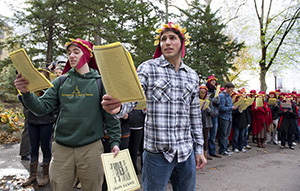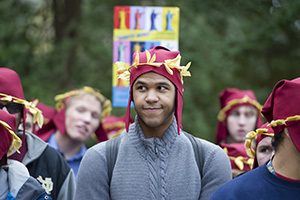Some may look at Dante’s “Divine Comedy” and see just a dusty trilogy of poetry written by a long-gone Florentine. But for others, Dante and his opus are immortal. For them, Dante is now.
In that spirit, Italian Studies at the University of Notre Dame and the William and Katherine Devers Program in Dante Studies in the College of Arts and Letters hosted “Dante Now!”—a series of public readings from “The Divine Comedy” with readings that occured simultaneously at various locations around campus during the fall semester.

Organizers said the event was meant to bring the “vibrant immediacy” of “The Divine Comedy” to life for a modern audience. “Students of Dante will know that reading his works alone and silently can be a life-changing experience, the fruits of which will endure and ripen,” said Anne Leone, postdoctoral research fellow in Italian studies. “But reading his works aloud—and together—promises to be another experience entirely.”
To best capture the music and rhythm of Dante’s poetry, the readings were in the original Italian, but English translations were provided to performers and spectators. Performance locations included the Word of Life Mural at the Hesburgh Library, the Clarke Memorial Fountain, the stairs of the Main Building, and the Knute Rockne Memorial Building.
“We chose locations that are conspicuous and popular since our hope was to encourage a wide range of people to stop by for a few moments and share this new experience with us,” Leone said.
Spectators were invited to join all 230 Italian students of every level in the celebration. According to junior Christian Coppa, shared performance is integral to reading the literature of Dante and an important part of the event. “Dante is always trying to engage his readers with the sound and texture of the language…it is something that we use our bodies to do. To properly read Dante is to perform it and that’s what this is really about,” he said.

The readings concluded with performers and spectators gathering at the Grotto for a communal recitation of St. Bernard’s Prayer to the Virgin, which forms the conclusion of Dante’s trilogy. Afterward, the Devers Program and Italian Studies at Notre Dame hosted an illustrative lecture titled “What’s Wrong With This Picture? How to Read Dante’s Hell” in the Hesburgh Libraries Department of Special Collections.
For sophomore Jonathan Gaworski, the communal reading was a powerful experience. “As we got going, as we got into it, you could see the attention pick up, you could feel the eyes looking until it seemed the whole area here in front of the grotto was looking and engaged, and then we got to our climax, our prayer to the Virgin, that’s kind of when we all looked up and just saw how everyone here was in it. It was fun. It was very fun.”
Christian Moevs, associate professor of Italian; and Theodore J. Cachey, Jr., the Albert J. and Helen M. Ravarino Family director of Dante and Italian Studies and chair of the Department of Romance Languages and Literatures, joined Justin Steinberg, associate professor of Italian literature at the University of Chicago, to interpret some of “the most powerful—and at times quite harrowing—moments in The Inferno, by reading them through a method analogous with the game from the comics page or the back of the cereal box, where the object is to figure out what’s wrong with the picture,” Leone said.
“This was an event for people who already love Dante, and also for those who don’t know much about him at all, and would like to know more,” she said.